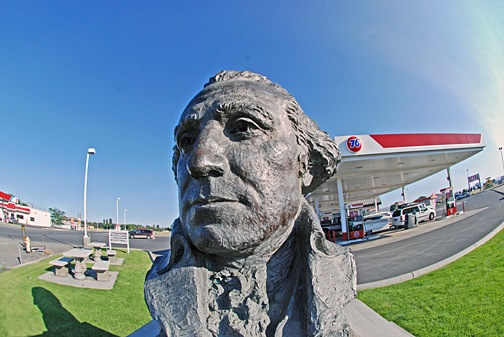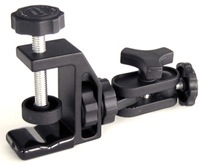But Mike gets to use it first!
I’d treated myself to a new camera lens late last month. When I returned from Washington last week, it was waiting for me at home.
 The lens is a Nikon 16-85mm f/3.5-5.6G AF-S DX ED VR Nikkor Wide Angle Telephoto Zoom Lens. It’ll replace the 18-55mm lens I bought on eBay last year — the same lens that crapped out on me about two months ago. (Another reason not to buy used camera equipment on eBay.) That lens was cheap and it felt cheap — lightweight and plasticky. This lens was costly and it has a weighty, quality feel to it.
The lens is a Nikon 16-85mm f/3.5-5.6G AF-S DX ED VR Nikkor Wide Angle Telephoto Zoom Lens. It’ll replace the 18-55mm lens I bought on eBay last year — the same lens that crapped out on me about two months ago. (Another reason not to buy used camera equipment on eBay.) That lens was cheap and it felt cheap — lightweight and plasticky. This lens was costly and it has a weighty, quality feel to it.
But that’s not why I bought it. It was the Amazon reviews that convinced me. Although I’ll never rely on reviews there to buy a book — I’ve been burned before, in more ways than one — I find that reviews of camera equipment are generally fair and reliable. It’s easy to identify fanboys and people with a gripe against the company. Weed those out and you can get some solid opinions of the products. In this case, just about all owners liked the lens.
But it was comments like these that sold me:
I have both the 18-135 and the 18-200, yet this lens has become my everyday go to lens for most of my photography. …Given the great sharpness (especially in the 16-50mm range), VR, and almost total lack of noticeable CAs, I can highly recommend the 16-85 for a general purpose, on-the-camera-all-the-time lens. – D80Shooter
I think 16-85mm VR and 70-300 VR lenses is probably all amateur like me needs, with light and compact 16-85mm VR lens mounted on camera most of the time. – Alex
This is how I was using the 18-55mm lens — as an everyday lens. This one promised more flexibility with better optics.
Of course, when I got back to Wickenburg, I had just 3 days to do a ton of stuff. I didn’t have time to play with the lens other than to snap a few photos in the kitchen to check the focal length range. Photography would have to wait.
 When we flew to Seattle on Friday, the new lens was in my camera bag with the rest of the camera equipment I take on the road. But with the back problems that have been slowing me down, I didn’t have time to do anything fun in Seattle, despite the fact that we had the whole day there. (I spent much of it sleeping off some painkillers.) The next morning, we began our helicopter flight from Seattle to Page. I was sitting up front, handling navigation while Louis flew. I had my hands full with directions for our scud-run south. I didn’t realize it at first, but Mike was sitting in back, snapping photos with the new lens. He continued to do so on both days of the flight and got quite a few good shots from the air. This photo, taken just outside of the Bryce Canyon area, is especially attractive to me because of the shadow created by the big, puffy, low clouds.
When we flew to Seattle on Friday, the new lens was in my camera bag with the rest of the camera equipment I take on the road. But with the back problems that have been slowing me down, I didn’t have time to do anything fun in Seattle, despite the fact that we had the whole day there. (I spent much of it sleeping off some painkillers.) The next morning, we began our helicopter flight from Seattle to Page. I was sitting up front, handling navigation while Louis flew. I had my hands full with directions for our scud-run south. I didn’t realize it at first, but Mike was sitting in back, snapping photos with the new lens. He continued to do so on both days of the flight and got quite a few good shots from the air. This photo, taken just outside of the Bryce Canyon area, is especially attractive to me because of the shadow created by the big, puffy, low clouds.
 My photography was limited to shots taken on the ground, like this photo of my helicopter at the Spanish Fork, UT airport. Although the photo doesn’t seem too interesting in this low-res shot, it’s really impressive in full-resolution, with clear detail of the clouds — enhanced with the use of a circular polarizing filter on the camera (not in Photoshop) — and dramatic mountains in the background. I think it’s my new favorite picture of my helicopter.
My photography was limited to shots taken on the ground, like this photo of my helicopter at the Spanish Fork, UT airport. Although the photo doesn’t seem too interesting in this low-res shot, it’s really impressive in full-resolution, with clear detail of the clouds — enhanced with the use of a circular polarizing filter on the camera (not in Photoshop) — and dramatic mountains in the background. I think it’s my new favorite picture of my helicopter.
I’ll be uploading the best photos from the flight to my gallery at Flying M Photos.
I’m in Page, AZ now, planning to spend the next month and a half flying tours around Lake Powell and Monument Valley. (You can learn more about my summer flying gigs on the Flying M Air Web site.) I’m also working hard this month to complete my 72nd book, which, unfortunately, I can’t talk about here. So while I’ll be very busy through August, I should have free time in September to go exploring. Antelope Canyon is less than 5 miles away and I expect to spend several mid-day sessions in Lower Antelope Canyon. There’s also an interesting rock formation called The Wave within 50 miles of here — not sure where yet — and if my back heals up, I’ll take a hike there. This new lens should be perfect for these tight locations, since it offers a really wide view without much distortion. (My fisheye lens can take some cool photos, but its a limited use lens.) I might also charter an airplane for some aerial photo work. Airplanes are extremely limited for this kind of work — helicopters are so much better — but it might be worthwhile to give it a try.
If you have a lens like this, I’d love to hear from you. Use the Comments link or form for this post to share your thoughts.


 I made a few test runs with the camera.
I made a few test runs with the camera. The solution was to use a tiny powered lapel mic (similar to the one shown here) that I happened to have for a cassette recorder. The mic’s pickup was small enough to fit inside my headset ear cup, dangling right over my ear. I secured it in there with a clip. Any sound that got to my ear would get to the recorder. And the Bose Generation X headset’s active noise cancellation would filter out much of the sound of the helicopter running.
The solution was to use a tiny powered lapel mic (similar to the one shown here) that I happened to have for a cassette recorder. The mic’s pickup was small enough to fit inside my headset ear cup, dangling right over my ear. I secured it in there with a clip. Any sound that got to my ear would get to the recorder. And the Bose Generation X headset’s active noise cancellation would filter out much of the sound of the helicopter running. For today’s flight to Sky Harbor, I made some changes to the mounting setup. I’d ordered a special mounting clamp from the V.I.O. people and it arrived on Wednesday afternoon. It would give me more flexibility in where I could mount the camera.
For today’s flight to Sky Harbor, I made some changes to the mounting setup. I’d ordered a special mounting clamp from the V.I.O. people and it arrived on Wednesday afternoon. It would give me more flexibility in where I could mount the camera. The second place I had in mind was where I actually attached it: on the vent opening for the pilot’s door. This mount, which is shown here in the photos I took with my Treo yesterday, has the camera head outside, pointing slightly to the right and slightly down. The rest of the unit is inside, fastened to the helicopter’s airframe. I have all wires securely attached to various things that’ll keep them away from my controls. And I wrapped the camera and mount with red electrical tape, which is somewhat elastic and easier to remove than duct tape. I showed the setup to Ed and he agreed that the camera was not likely to come loose during flight.
The second place I had in mind was where I actually attached it: on the vent opening for the pilot’s door. This mount, which is shown here in the photos I took with my Treo yesterday, has the camera head outside, pointing slightly to the right and slightly down. The rest of the unit is inside, fastened to the helicopter’s airframe. I have all wires securely attached to various things that’ll keep them away from my controls. And I wrapped the camera and mount with red electrical tape, which is somewhat elastic and easier to remove than duct tape. I showed the setup to Ed and he agreed that the camera was not likely to come loose during flight.